Rolf Potts's Blog, page 127
May 23, 2011
The goal of travel is to return transformed
"It may sound naive, but when you enter a cross-cultural situation, you are by definition an ambassador for your culture. Decency and pride dictate that we present ourselves well, with respect and integrity. Think of every such cultural encounter as a reciprocal obligation. If you make a promise to return to a village, to send a photograph, keep it. Always leave behind more than you bring away, give more than you take. Whether we travel as tourists, journalists, or academic anthropologists, it is our comparative wealth that allows us to be in these places, to have these life-affirming interactions. This is always a privilege but never a right. The goal of travel is to return transformed. And that's the gift of engagement with another cultural reality."
–Wade Davis, "On Native Ground," Condé Nast Traveler, December 2008
May 21, 2011
Weekly RTW Inspiration and Information: Round the World Wednesday
Some travelers may pick a destination from a list, plan a week-long trip there, and move on to the next spot. The planning for such a vacation can be done quickly, including any last-minute prep you might feel like doing on the plane. Long-term travelers, on the other hand, tend to take longer to plan out their trips – these are, after all, epic journeys of several months to several years, so it only makes sense to take longer than a day to figure out the details.
The trouble with such drawn-out planning is that it's easy to get sidetracked by something else and put off the next steps in your RTW trip planning process for another day or week. Regular reminders of your travel goals are helpful, especially if they're also providing planning tips. This is only one of the reasons we're so excited about a new series on BootsnAll dedicated to RTW travel – it's Round the World Wednesday.
Every week, we'll feature a new article in the Round the World Wednesday series designed to help long-term travelers. Some articles will de-mystify an aspect of RTW travel, such as how you really can afford to travel long-term. Some articles will let readers in on little secrets to help them get more out of their trips, like the "stopover secret." Some articles will cover topics that are common to every RTW traveler's planning process, like how to decide where to go on a RTW trip.
We hope you'll tune in every Wednesday to find out what's new in the Round the World Wednesday series, and that it'll serve as a weekly reminder of your travel aspirations. For even more RTW travel tips, don't forget to sign up for BootsnAll's RTW Travel Newsletter, delivered monthly via email.
May 20, 2011
The art of unplugging for a trip

A tangled web of gadgets. Photo: Peter Kaminski / Flickr
In my last couple of blog posts, I waxed poetic about the life of a digital nomad. As a counterpoint, here's a fine article that appeared in the Orange-County Register: Digital detox for a trip to Italy. Gary Warner, the newspaper's travel editor, decided to cut off the electronic umbilical cord for an entire vacation. With today's gadgets and social networks, many of us have become used to (addicted to?) instant feedback from our friends. Going cold turkey can be tough.
Warner is no Luddite and tech-basher. He does acknowledge how technology can enrich travel and make it more convenient. However, he does point out a big danger: technology can bring home on the trip with you, with all its attendant baggage and stress. In his words:
I found the computer and phone gave me an agitated feeling. My body might be on the road, but my head was at my desk thousands of miles away. Even GPS had stripped away the serendipity of getting wonderfully lost. Did I really need–did I really want–the "least time" route from Skye to Inverness?
Warner's observations are similar to the ethos our own Rolf Potts trumpeted in his book Vagabonding. An over-reliance on things like the Internet might blind us to the exotic locale we came all this long way to discover.
Here are some things I do to moderate my dose of technology:
–Get online early in the morning. People are asleep, businesses are closed, so you're not missing out on anything. If you check e-mail sometime later in the day or evening, you risk losing your chance to join some cool people for a meal or a fun night out.
–Read, but don't reply. I've easily wasted hours by writing blow-by-blow accounts in e-mails to friends. Unless it's really urgent, it's better to postpone replying to every message you get.
–Don't get caught up in documenting every aspect of your trip. With blogging and social networks, it's easy to get sidetracked by "recording" your travels with photos, video, and text updates. Rather than living our travels. This is why I always write posts on my travel blog after I've returned from a place, not while I'm there. While I do keep a travel journal, I strictly write bullet-point lists of key events and details, not full-length stories. I save that heavy-duty writing for my blog. Your record-keeping style may vary, though.
Have you ever been cut off from the Internet for an extended length of time? Were you excited to get online and see all the messages from your friends? But have you ever been disappointed by what was in your inbox? Warner sure was:
Of course, I re-toxed as soon as I got home. Though it was past midnight when we finally came in the door from the airport, I pulled my devices from the drawer and fired them up. More than 1,200 emails, more than 1,000 tweets from feeds . . . When I scrolled and clicked through it all, I found I had missed absolutely nothing that mattered.
In a way, this reinforces that we can live without technology. Warner's home life didn't collapse while he was unplugged. For more, please check out Rolf Potts' interview with Gary Warner.
Have you met people who couldn't seem to get offline? How do you keep from over-using technology? Please share your thoughts in the comments.
May 19, 2011
Tweeting from the summit of Everest
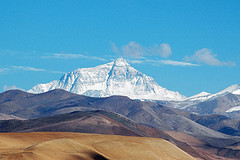 Often while traveling, it seems that there's no place immune from a wireless connection. Hotels, cafés—even buses allow you to connect with the world using your cell phone, laptop, or notebook.
Often while traveling, it seems that there's no place immune from a wireless connection. Hotels, cafés—even buses allow you to connect with the world using your cell phone, laptop, or notebook.
It's been many years since I've heard someone make a call from an airplane using those seat-back phones: "Hey, you'll never guess where I'm calling you from." I suppose that's part of the allure for calling or tweeting from remote places. Recently, mountaineer Kenton Cool tweeted from Everest's summit, and then called his wife. If you thought Everest was one of the few places that were immune from social networking, you can cross it off your list now.
Only a few years ago, I was completely off the grid when I visited my home in Honduras. I'd have to take a boat ride for an hour to use the telephone—when it worked. Cell service was nonexistent. Now, I can email from my place while looking at three cell phone towers on the nearby mountains.
Lamenting the days of getting off the map and away from technology is a waste of time. Ultimately, it's all under your control. Want to get away from email, Facebook and Twitter? Don't use it. You don't even have to leave your gear at home. Just determine when you want to connect and when you don't. This week, I'm in Colombia and will be in the jungle part of the time. I'm relishing the ability to shut everything off and ignore my electronic leash.
How about you? Do you yearn to shout from the social network mountaintop when you're connected in a remote place, or would you rather just enjoy and talk about it later?
May 18, 2011
STA announces 2011 World Traveler Interns
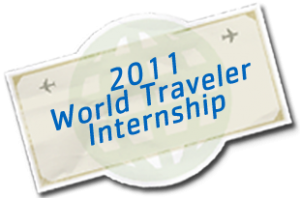 It's that time of year again when STA travel picks this summers World Traveler Interns and the two lucky candidates have been announced. The 2011 interns are Brigette Muller and Dutch Simpson. You can read more about who they are and what inspired them to apply for the position here, on the STA website.
It's that time of year again when STA travel picks this summers World Traveler Interns and the two lucky candidates have been announced. The 2011 interns are Brigette Muller and Dutch Simpson. You can read more about who they are and what inspired them to apply for the position here, on the STA website.
This years itinerary takes us across 17 countries. The journey starts with a long winding path across Europe, through a bit of Asia, and finally touches down in Australia, New Zealand, and parts of South America. STA's World Travel Interns are always fresh and fun to watch. Be sure to check out their progress this summer on what is sure to be an exhilarating journey.
Book Review: Saving by Beauty in Iran
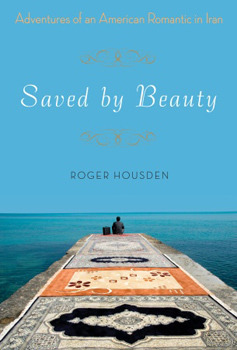 I've wanted to go to Iran for nearly as long as I've been traveling. There is no other country that I have heard travelers so universally praise — the people, the culture, the food; it's rare to meet anyone with something bad to say about Iran. Unless of course you're talking politics.
I've wanted to go to Iran for nearly as long as I've been traveling. There is no other country that I have heard travelers so universally praise — the people, the culture, the food; it's rare to meet anyone with something bad to say about Iran. Unless of course you're talking politics.
British-American author and poet Roger Housden has a new book out that's only further fueled my desire to see Iran. Housden's Saved By Beauty: Adventures of an American Romantic in Iran weaves a tale through Iranian people, culture and poetry in an attempt to unlock the secrets of a complex land, which, for most westerners, is largely known through negative headlines.
"The image of Iran as a dark and scary place," writes Housden, "remains a difficult one to dislodge from the collective imagination." But Housden does an admirable job, and does it without ignoring the political, religious and cultural realities of Iran. Indeed, thanks to an opening chapter cut short — in which Housden is detained, questioned and threatened with prison — the threat of Iran's political realities hangs over the rest of the book. It works on two levels, constantly in the back of the reader's mind, making the book something of a page turner as you wait to find out what will happen, and also, I imagine, not unlike the subtle threat that hangs over Iran more generally — traveling in the midst of beauty while never forgetting the harshness of the government that currently presides over that beauty.
Thanks to Housden's skill as a writer, Saved By Beauty is indeed a beautiful read. Housden's previous books include one on the famous Iranian poet Rumi, and the poetry of Iran threads through this new book, creating a tapestry that helps pull together some of Housden's rather disparate experiences in the country.
The title comes from a line in Fyodor Dostoyevsky's novel The Idiot, where Prince Myshkin says, "I believe the world will be saved by beauty." Housden makes a similar claim in the pages of Saved By Beauty, though more with a sense of hope than with the sense of conviction Dostoyevsky's Myshkin has.
Of course between the time when Housden left Iran and the publication of Saved By Beauty reformers in Iranian rose up in protest and were brutally put down by the government.
But lest you get the idea that Saved By Beauty is about Iranian politics, it's decidedly not. It's about beauty–the beauty to be found in the land and architecture of Iran, as well as the people. As Housden points out in the book, despite Iran's current political situation, it is a nation that builds monuments not to generals, but to poets and Sufis (Muslim mystics). And it's not just Sufi monuments Housden encounters, but the everyday world of Iran as well:
Sufism is a gateway to the miraculous… For Iranians, even for those of a secular bent –of whom there are many– another dimension is always felt to be near at hand. They even have a word for it, al ghayb, the unseen world that can move mountains in this one. Rather than blind faith, the existence of al ghayb requires a an imaginative leap, a leap that is willing to conceive that the world itself might run at any moment on a different axis.
As any traveler knows, it takes very little to suddenly find your world and the world around you turning on an unexpected axis, and Housden's book is full of experiences vagabonds can relate to — both positive and negative.
Saved By Beauty also delves into common western misconceptions–like the idea that all Iranian women wear black chadors, they don't–and untangles the reality from the images found in popular media. While he doesn't try to sugarcoat the reality of women's lives in Iran, Housden does cut through stereotypes to reveal something much more complex and nuanced.
If, like most of us, your perception of Iran is based on what filters into our lives through western camera lenses and pens, Housden's book is a kind of revelation. Not that Iran is somehow much freer than you imagined (though it may well be), but that, as with anything, there is always much more to the story than fits in the brevity of soundbites.
Saved By Beauty is above all else a kind of love poem to Iran, one well worth reading even if you have no interest in visiting. I highly recommend picking up a copy. Saved By Beauty is currently on sale at Amazon ($15) or pick up a copy at your favorite bookstore.
May 16, 2011
Walking is the age-old form of travel
"Walking to ease the mind is an objective of the pilgrim. There is a spiritual dimension too: the walk itself is part of the process of purification. Walking is the age-old form of travel, the most fundamental, perhaps the most revealing."
–Paul Theroux, The Tao of Travel (2011)
(2011)
Your culture affects every aspect of your life
"Our culture is our routine of sleeping, bathing, dressing, eating, and getting to work. It is our household chores and the actions we perform on the job; the way we buy goods and services, write and mail a letter, take a taxi or board a bus, make a telephone call, go to a movie, or attend church. It is the way we greet friends or address a stranger, the admonitions we give our children and the way we respond, what we consider good and bad manners, and even to a large extent what we consider right and wrong. All these and thousands of other ways of thinking, feeling, and acting seem so natural and right that we may even wonder how else one could do it. But to millions of other people in the world every one of these acts would seem strange, awkward, incomprehensible, unnatural, or wrong. These people would perform many, if not all, of the same acts, but they would be done in different ways that to them would seem logical, natural, and right."
–Ina Corinne Brown, Understanding Other Cultures (1963)
May 13, 2011
Telecommuting like a pro
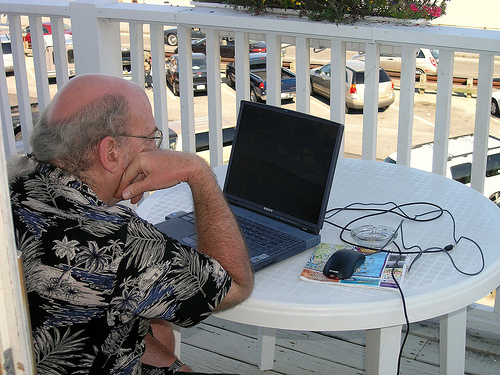
Man using laptop on a deck. Photo: gailf548 / Flickr
Looking to take your work on the road with your travels? The technology is available. There is a lack of role models, though. It would be great if we all knew digital nomads we could learn from. What would you ask a successful one if you had the chance?
Enter Chris Jankulovski. The CEO of Remote Staff gave a behind-the-scenes look at his cool lifestyle in this in-depth interview on Mixergy. You have the choice of watching their video chat or reading the transcript.
Beyond discussing the tools of the trade, Jankulovski gives an honest and informative opinion on the ups and downs of working in this modern way.
For example, how do you focus on getting things done when you've got the world's most beautiful scenery on your doorstep? How do you deal with the added complexity of bringing your family on the road? Jankulovski answers all of these hard questions and more.
Some of the most interesting parts were about how travel shaped his view on relationships. I won't spoil it, but Jankulovski took a surprisingly direct approach to meeting dating partners abroad. Not the usual encountering someone at a hostel.
Have you worked remotely? Please share your experiences in the comments.
May 12, 2011
Talavera in Puebla
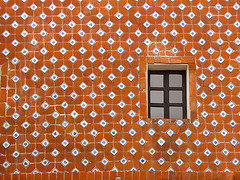 The colonial city of Puebla in Mexico lures travelers eager to taste its own culinary creations (among which are mole poblano and chiles en nogada), watch the traditional Cinco de Mayo parade, or shop for Talavera pottery. And while in many destinations, artistic creations are only available in museums and shops, a short walk down any street in downtown Puebla makes it seem as though the city is covered in Talavera tiles.
The colonial city of Puebla in Mexico lures travelers eager to taste its own culinary creations (among which are mole poblano and chiles en nogada), watch the traditional Cinco de Mayo parade, or shop for Talavera pottery. And while in many destinations, artistic creations are only available in museums and shops, a short walk down any street in downtown Puebla makes it seem as though the city is covered in Talavera tiles.
A type of majolica earthenware, Talavera is named after the Spanish town of Talavera de la Reina, where many craftsmen lived. The craft was adapted in Puebla after the city was founded in 1531, and became known as Talavera Poblano. Puebla became the most important earthenware center of Mexico.
There are plenty of shops—from the grand Talavera Uriarte to stalls in the Mercado el Parian—where you can get a choice piece of pottery. But don't pay so much attention to the shops that you ignore the plentiful buildings in town that are awash with colorful Talavera tiles. Even the church domes are slathered in brilliant tiles.
On my recent trip, I quickly gave up counting the different types of designs and just focused on enjoying them. I'm sure I missed a building here and there, but that's what return trips are for, isn't it?
Rolf Potts's Blog
- Rolf Potts's profile
- 321 followers



